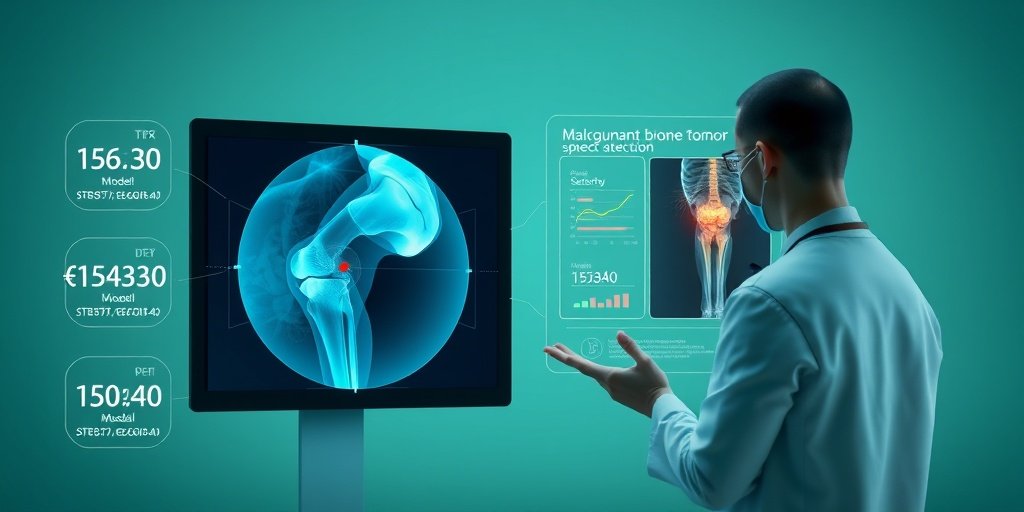⚡ Quick Summary
This study explored the effectiveness of same-modality cross-domain transfer learning for detecting malignant bone tumors in knee radiographs, comparing it to a model trained from scratch. The results indicated that while the overall AUC was similar, the transfer learning model demonstrated superior performance at clinically relevant thresholds, reducing false positives significantly.
🔍 Key Details
- 📊 Dataset: 743 radiographs (268 malignant, 475 normal)
- ⚙️ Technology: YOLOv5-based detectors (transfer learning vs. scratch)
- 🏆 Performance Metrics: AUC, sensitivity, specificity, PPV
- 🔬 Study Design: Trained/validated on institutional data, tested on an independent external set
🔑 Key Takeaways
- 📈 AUC values were comparable: YOLO-TL 0.954 vs. YOLO-SC 0.961.
- 🔍 At high-sensitivity points, YOLO-TL achieved higher specificity (0.903 vs. 0.867).
- 📉 YOLO-TL reduced approximately 17 false positives among 475 negatives.
- 💡 At high-specificity points, YOLO-TL showed higher sensitivity (0.798 vs. 0.764).
- 🏅 Youden-optimal point favored YOLO-TL with sensitivity of 0.914 vs. 0.892.
- 🌟 Transfer learning enhances practical performance at clinically crucial thresholds.
- 🩺 Clinical utility is improved by maintaining high detection rates while reducing false positives.
- 🌍 This approach supports the development of robust AI systems for rare diseases.

📚 Background
Detecting malignant bone tumors poses a significant challenge due to the rarity of these diseases and the limited availability of annotated data for training artificial intelligence (AI) models. Traditional methods often struggle with accuracy, leading to the exploration of advanced techniques like transfer learning, which leverages existing models trained on different but related tasks to improve performance in specific applications.
🗒️ Study
The study involved a comparative analysis of two YOLOv5-based detectors, one utilizing transfer learning from chest radiographs and the other trained from scratch on knee radiographs. The models were trained and validated on institutional data and subsequently tested on an independent set of 743 radiographs, comprising both malignant and normal cases.
📈 Results
The findings revealed that while the overall AUC values were similar between the two models, the transfer learning model (YOLO-TL) exhibited enhanced performance at critical clinical thresholds. Specifically, YOLO-TL achieved higher specificity and positive predictive value (PPV) at high-sensitivity points, effectively reducing the number of false positives, which is crucial for clinical decision-making.
🌍 Impact and Implications
The implications of this study are significant for the field of radiology and oncology. By demonstrating that same-modality cross-domain transfer learning can improve the practical performance of AI models, this research supports the integration of advanced AI technologies into real-world screening workflows. This could lead to more accurate and efficient detection of rare diseases, ultimately improving patient outcomes and resource allocation in healthcare settings.
🔮 Conclusion
This study highlights the potential of transfer learning in enhancing the detection of malignant bone tumors through radiographic analysis. While the overall AUC may not show substantial improvement, the practical benefits at clinically relevant thresholds underscore the value of this approach. Continued exploration of AI in healthcare is essential for developing robust tools that can be readily accepted in clinical practice.
💬 Your comments
What are your thoughts on the use of transfer learning in medical imaging? We would love to hear your insights! 💬 Join the conversation in the comments below or connect with us on social media:
Utility of Same-Modality, Cross-Domain Transfer Learning for Malignant Bone Tumor Detection on Radiographs: A Multi-Faceted Performance Comparison with a Scratch-Trained Model.
Abstract
BACKGROUND/OBJECTIVES: Developing high-performance artificial intelligence (AI) models for rare diseases like malignant bone tumors is limited by scarce annotated data. This study evaluates same-modality cross-domain transfer learning by comparing an AI model pretrained on chest radiographs with a model trained from scratch for detecting malignant bone tumors on knee radiographs.
METHODS: Two YOLOv5-based detectors differed only in initialization (transfer vs. scratch). Both were trained/validated on institutional data and tested on an independent external set of 743 radiographs (268 malignant, 475 normal). The primary outcome was AUC; prespecified operating points were high-sensitivity (≥0.90), high-specificity (≥0.90), and Youden-optimal. Secondary analyses included PR/F1, calibration (Brier, slope), and decision curve analysis (DCA).
RESULTS: AUC was similar (YOLO-TL 0.954 [95% CI 0.937-0.970] vs. YOLO-SC 0.961 [0.948-0.973]; DeLong p = 0.53). At the high-sensitivity point (both sensitivity = 0.903), YOLO-TL achieved higher specificity (0.903 vs. 0.867; McNemar p = 0.037) and PPV (0.840 vs. 0.793; bootstrap p = 0.030), reducing ~17 false positives among 475 negatives. At the high-specificity point (~0.902-0.903 for both), YOLO-TL showed higher sensitivity (0.798 vs. 0.764; p = 0.0077). At the Youden-optimal point, sensitivity favored YOLO-TL (0.914 vs. 0.892; p = 0.041) with a non-significant specificity difference.
CONCLUSIONS: Transfer learning may not improve overall AUC but can enhance practical performance at clinically crucial thresholds. By maintaining high detection rates while reducing false positives, the transfer learning model offers superior clinical utility. Same-modality cross-domain transfer learning is an efficient strategy for developing robust AI systems for rare diseases, supporting tools more readily acceptable in real-world screening workflows.
Author: [‘Hasei J’, ‘Nakahara R’, ‘Otsuka Y’, ‘Takeuchi K’, ‘Nakamura Y’, ‘Ikuta K’, ‘Osaki S’, ‘Tamiya H’, ‘Miwa S’, ‘Ohshika S’, ‘Nishimura S’, ‘Kahara N’, ‘Yoshida A’, ‘Kondo H’, ‘Fujiwara T’, ‘Kunisada T’, ‘Ozaki T’]
Journal: Cancers (Basel)
Citation: Hasei J, et al. Utility of Same-Modality, Cross-Domain Transfer Learning for Malignant Bone Tumor Detection on Radiographs: A Multi-Faceted Performance Comparison with a Scratch-Trained Model. Utility of Same-Modality, Cross-Domain Transfer Learning for Malignant Bone Tumor Detection on Radiographs: A Multi-Faceted Performance Comparison with a Scratch-Trained Model. 2025; 17:(unknown pages). doi: 10.3390/cancers17193144